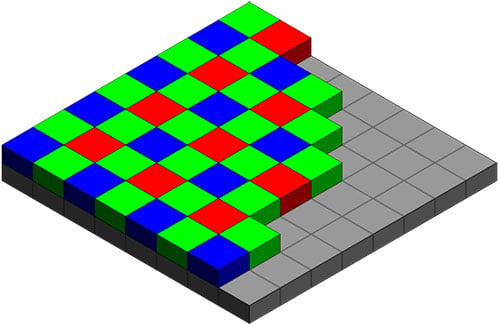Yes, it’s post-processed. I get this question all the time, like every other photographer on the planet, and it often sparks heated debates that challenge the notion of objective reality and the meaning of photography.
My claim is: all photographs are post-processed (in one way or the other).
Without diving too much into the technical details, and only touching digital photography, a photograph is the result of light hitting a digital sensor that records the image as a number for each sensel (sensor element). The sensels are arranged in what is called a Bayer Filter Mosaic.

I’m ignoring Foveon-like sensors, which work slightly differently, but they don’t really change significantly the nature of the argument.
The RAW image, which comes from reading the Bayer Filter Mosaic, can not be visualized without a transformation to create an RGB image that can be displayed on a screen or printed on paper.
The interpretation of the raw file to reconstruct colors from the Bayer Filter Mosaic (what is often referred to as “Color Science”) and produce the final image applies a number of subjective transformations and selectively throws away information. The subjective interpretation must happen somewhere between capturing an image and displaying it. Someone has to take the subjective decisions about what information to throw away, what information to keep and how to transform the information to be able to visualize it.
This is post-processing.
![]()
When you read “no filter” or “straight out of camera”, what you are really reading is “I’m leaving the post-processing choices to the engineers who designed the camera”.
As an artist, I want to make the decisions on how the final image looks myself, which is why I further post-process the images starting from the RAW file. But it’s not reality!
This is a common cry. What is reality, really? Two people in front of a scene will likely have different memories of the same scene and feel different feelings. Human memory is not photographic, anyway.
And photography must not necessarily be a faithful recording of reality. It can not be, anyway, faithful in the first place because the very concept of faithful reality can not be univocally defined.
My claim is that, in photography, any amount of post-processing, from straight out of camera to mixing different images taken in different places and different times, is legitimate as long as the author is faithful to their artistic intent.
![]()
My artistic intent is to produce an image that communicates my feelings in front of the scene in the purest form.
My artistic statement is an arbitrary choice that appeals to my sense of esthetics, to how I enjoy doing photography and to what I want to communicate with my work. I don’t claim this statement is universal, better or worse than any other artist’s statement or that it must apply to anyone else other than to me.
From my artistic statement, I can derive rules to apply to my photography. For example, I don’t substitute the sky in my images with a sky taken from a different location at a different time. It’s perfectly legitimate to do so, but since a different sky did not contribute to my feelings in front of a scene, this is something I do not do.
On the other hand, my artistic statement allows me to clone out elements, stretch and generally modify the geometry of my images. If I’m cloning something out of a scene, it means that this particular element did not contribute to my feelings in front of that scene.
Someone else might have noticed the same element in front of the same scene and might consider it part of their story. Both choices are legitimate.
![]()
So, yes, my photograph is post-processed to make my stories as strong as possible for you.
About the author: Francesco Carucci is a fine art landscape photographer who was formerly an accomplished game developer. The opinions expressed in this article are solely those of the author. Carucci has produced several internationally recognized and exhibited works from the USA to China. You can find more of Carucci’s work on his website, Facebook, and Instagram. This article was also published here.

